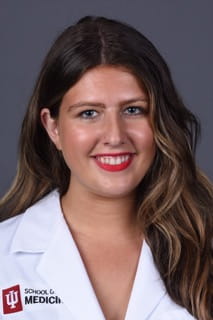Individuals living with diabetes use CGMs to stay alert about impending glucose changes by using appropriate alarm settings. Ensuring accurate settings are in place helps alert patients to dangerously low or high blood sugar levels. However, there is limited data on how real-time CGM alarms are used by a large clinical pediatric population. Victoria Ochs, an Indiana University School of Medicine student focused on diabetes clinical research, collaborated with the Pediatric Diabetes and Endocrinology group at Riley Hospital for Children to learn more about young patients’ device habits.
Ochs’ study addressed this gap in knowledge by using device summaries and describing trends in alarm use from 150 patients who used Dexcom G6 continuous glucose monitoring devices. Her research identified significant gaps in the proper use of CGM alarms by children and teenagers with diabetes.
“This study sheds light on the variability of real-time CGM alarms in pediatric populations,” said Ochs. “Our findings show that there might be some areas where patients and caregivers need more guidance and training to use CGMs and their alarms correctly. Fixing these gaps could help kids with diabetes better control their glucose levels and overall health.”
The results showed that patients use a large range of alarm settings and cutoffs, many of which differ significantly from recommended values. Only 87 percent of the study participants had set low alarm alerts, and 73 percent had set high alarm alerts. Furthermore, children using insulin pumps and patients under the age of 12 were more likely to employ alarms. The wide variability of observed alarm settings indicates likely educational gaps in CGM onboarding and use. The differences in CGM alert use between age groups as well as by insulin delivery methods may indicate opportunities to optimize alarm use.
 “As a type 1 diabetic for 13 years and a CGM user myself, I am passionate about helping other people with diabetes have more comfortable lives,” said Ochs. “I hope my research brings extra awareness to the importance of proper CGM use for families with diabetes so more young patients are better prepared to use their devices safely and correctly."
“As a type 1 diabetic for 13 years and a CGM user myself, I am passionate about helping other people with diabetes have more comfortable lives,” said Ochs. “I hope my research brings extra awareness to the importance of proper CGM use for families with diabetes so more young patients are better prepared to use their devices safely and correctly."
Ochs’ research project was funded with support from the Short-Term Training Program in Biomedical Sciences Grant T35 HL 110854 from the National Institutes of Health. Ochs also recently presented her research at the Endocrine Society’s annual meeting, ENDO 2023 in Chicago, Illinois. More than 7,000 attendees joined the event to engage with peers at the top global meeting on endocrinology research and clinical care. Ochs’ abstract titled, “Assessing Continuous Glucose Monitor Alarm Use by Families of Children with Diabetes” was selected out of thousands of submissions and recognized by the Endocrine Society for her study’s significance to the diabetes community.
